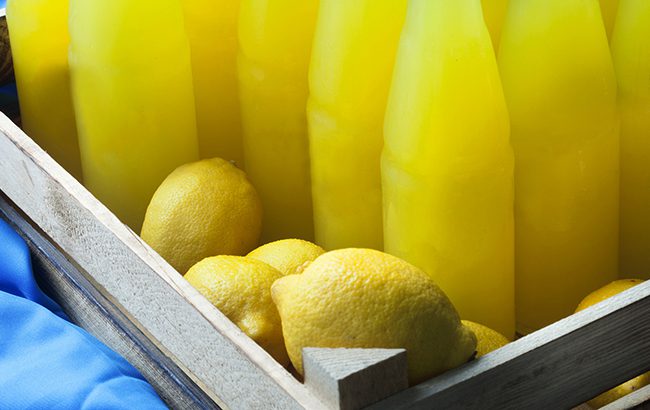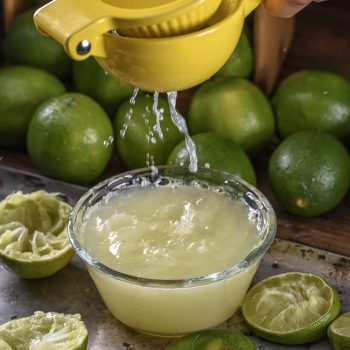Everything you need to know about super juice
TikTok and Instagram are awash with videos about super juice – but what’s the story behind the trendy citrus juice and how do you make it?

According to its creator Nickle Morris – whose name is often absent from the conversation – we shouldn’t really be talking about super juice. “Every TikTok that’s ever been made [about super juice] was done without my permission or consultation, and they don’t know what they’re talking about,” he explains. “What you will see is a lot of people will mix it up, and they’ll only call it super juice. The final product is super juice. The process is called oleo citrate.”
While certain TikTok influencers like to refer to it as “lime juice on steroids”, Morris summarises oleo citrate as “an alternative method for maximising the functionality of citrus and the shelf life”. It’s a less exciting description but one that’s significantly more accurate.
You can find Morris’ full method below, but the short version is that you need to peel your citrus fruits, cover the peels in citric and malic acid, and leave them alone for a while. Then add water to the peels, blend them and strain, before adding in the fresh juice from your fruits.
The science is that the majority of a citrus’ flavour is in its peels. “I’ve been doing cocktails for almost 20 years now,” Morris says, explaining that when the cocktail scene began its renaissance in the late 20th century, “it was very important to hand-squeeze in a C-press, because you wanted the oil from the skins. Oleo citrate uses that oil to reconstitute the same equivalent juice.”

Why is super juice useful?
When Morris first started working on oleo citrate, he was looking for a way to create the then-newly rediscovered Last Word cocktail without shaking. For most people, however, the benefit of the technique is maximising the yield of a citrus fruit. Originally, this benefit helped with costs, but today, more emphasis is placed on its sustainability advantages.
Hyacinthe Lescoët is the co-founder of The Cambridge Public House in Paris, which last year became the first bar in the world to be B Corp-certified. “The best possible situation would be to not use any citrus juice at all, or at least not in geographical location where it doesn’t grow, nor outside of seasons,” he explains. “However, super juice is an amazing way to get the best out of a fruit while reducing waste and cost. It has a longer shelf life, creates more quantity of juice and reduces your environmental impact.”
Andy Nelson, director of beverage experience at IHG Hotels & Resorts, adds that the technique can be adapted for acid correction. “Super juice allows our beverage teams to create flavours from fruits that don’t grow in various regions and offers a more sustainable solution year-round,” he explains. The brand’s Kimpton Grand Roatán Resort & Spa in Honduras, for instance, uses acid-corrected local citruses to replace lemons in cocktails.
“We measure the pH balance of other fruits available in the area, like oranges and grapefruits. Once we have those measurements, we can calculate how much citric acid we need to add to bring the pH balance up to 2.5, which is the average pH balance for lemon juice.”
Super juice misconceptions
These innovations are helping take the industry forward in terms of techniques and sustainability, but Morris wants to emphasise that using the wrong terminology and riffing on the method is causing confusion.
“We have definitely slipped on technique as a community,” he explains. “Lime super juice is bright green – you don’t even need to label it. It’s very, very easy to see. The same goes for lemon juice. It becomes a very bright yellow – that’s because you’re getting the colour out of the skin.”
The proliferation of incorrect recipes online is a real bugbear for him. “It took me quite a while to come up with oleo citrate. It was a lot of thought, but it was also a decent amount of genuinely screwing up. That’s why I get upset when people are like: ‘Oh, you didn’t invent it.’ I assure you, I did, and it involved a great deal of mistakes.”
To figure it out, Morris first started by playing with essential oils – “but most of those things, even the food-grade ones, are pretty garbage, and they’re very difficult to get to mix with the water for obvious reasons.”
His biggest hurdle was grasping how to extract those oils naturally. While he pondered that mystery, he got a job working for Road Soda, which offered draft cocktails from a trailer at events. “Citrus would clog [the keg system] all the time. The reason lemon and lime juice is opaque is because it has very small plant particulates in there.”
To get the kegs running smoothly, he needed to remove the pulp from the juice, which brought him back to the question of using the oils in peel. He realised that lots of things, such as protein powder or Kool-Aid packages, use “an inert medium to hold on to whatever you need” – maltodextrin being a common one. He wondered if he could use an inert medium to take the oil out of the skins, the same way sugar is used in an oleo saccharum.
Growing up in Tucson, Arizona, he often made carne asada, which uses citric acid to tenderise the meat. “Everybody’s got citric acid in their house in Tucson,” he laughs. He realised the citric acid must have an inert body in it and played around adding it to citrus peels.
 The result was great for Road Soda, but the mouthfeel was a little off. “It was perfect for making 60,000 cocktails a weekend to serve at Coachella, which is what we did. But I needed more.” Without the plant particulate, the liquid was much thinner than in regular citrus juice. “Think of the viscosity difference between whole milk and water.”
The result was great for Road Soda, but the mouthfeel was a little off. “It was perfect for making 60,000 cocktails a weekend to serve at Coachella, which is what we did. But I needed more.” Without the plant particulate, the liquid was much thinner than in regular citrus juice. “Think of the viscosity difference between whole milk and water.”
A new role in Kentucky called, where Morris continued with experiments, this time adding fresh juice – “but it still felt light”. As with all great experiments, the solution was a mistake. He forgot about one of his cups, and when he discovered it, all of the acid had been absorbed into the peels.
“I realised the only way I was going to get anything was if I blended the whole mess up and strained it. So I did that, and that’s how I got the final product, because when I blended and strained it, I had the plant particulate back.”
From Nickle Morris to the world
Morris decided to release his invention to the world in 2020, when his partner at the time, Lindsey Johnson, convinced him it would be helpful to bartenders struggling during the pandemic. He agreed to host an online masterclass for Portland Cocktail Week.
“I won’t say I regret it, but it probably wasn’t the way I should have presented it to the world,” he explains. “It’s taken on a life of its own.”
How would he do things differently today? “I wish I’d been more comprehensive, and more clear, louder.” Giving the seminar at the beginning of the pandemic, Morris had no idea how it would be received, or how many people would be willing to tune in digitally. “We didn’t know how the pandemic was going to affect the [bar] business. We all assumed it was going to kill it.”
Publishing a book may have helped to formalise things, “but I’m just not that type of guy,” he explains. “I don’t like the idea of capitalising off of it financially. There’s a reason I’ve never patented it – I could. People with medical patents are assholes, and I think this is no different.
“I know it’s not medicine, but it is really helpful. It really can change the whole complexion of your programme, especially if you have a juice-heavy programme. I didn’t want that to be something people had to pay me for.”
He’s happy without remuneration for his work, but he wishes more people would turn to him for advice. “When I started in this business, I would have given anything to have a conversation with Jerry Thomas, Ada Coleman or Tom Bullock,” he says. “They gave us all these amazing drinks and great techniques.”
Instead, some influencers tell Morris they’re doing him a favour by popularising his technique. “They’re making money from telling people my idea – without including me, and often getting it wrong. Calling it super juice and not oleo citrate – it shows not just an ignorance, but a lack of respect for the information.
“I wish those people would have just reached out to me and had me be a part of the conversation so that I could explain. I’m 37 years old. I’m not a dead guy. I’m not Harry Craddock. If you want to ask me about something, I’m right here.”
Nickle Morris’ oleo citrate
For one litre of lime oleo citrate
- 100g Lime peel
- 44g Powdered citric acid
- 7g Powdered malic acid
Combine all ingredients in a soup cup, shake to evenly cover peels with the acid mix.
Let rest for 60 minutes, add cold water and blend. Strain.
Add in fresh juice from peeled fruit. Label and date.
For one litre of lemon oleo citrate
- 100g Lemon peel
- 47g Powdered citric acid
- 9g Powdered malic acid
Combine all ingredients in a soup cup, shake to evenly cover peels with the acid mix.
Let rest for 60 minutes, add cold water and blend. Strain.
Add in fresh juice from peeled fruit. Label and date.
For one litre of orange oleo citrate
- 120g Orange peel
- 23g Powdered citric acid
- 2g Powdered malic acid
- 70g Granulated sugar
Combine all ingredients in a soup cup, shake to evenly cover peels with the acid/sugar mix.
Let rest for 60 minutes, add cold water and blend. Strain.
Add in fresh juice from peeled fruit. Label and date.
For one litre of grapefruit oleo citrate
- 100g Grapefruit peel
- 15g Powdered citric acid
- 2g Powdered malic acid
- 4g Powdered glutamic acid
- 70g Granulated sugar
- Bitter husk stock*
*For bitter husk stock
- 100g juiced husk
- 2 litres Filtered water
Combine pith and water, then reduce over a boil to one litre. Straight the bitter husk stock and set aside.
Combine peels and acids, set for 60 minutes and blend with the bitter husk stock.
Add in fresh juice from peeled fruit. Label and date.
Related news
Mataroa Gin features at Roma Bar Show
